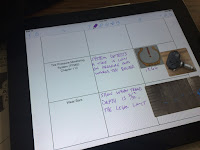Using Learning Objectives in Class
Last week’s blog post reflected on the value of writing learning objectives for our courses in order to better communicate where we are going in our instruction and learning. But once we’ve written these great objectives, what are some ways that we can effectively use them in the classroom, and more importantly, how can the students use them?
In Ms. +Carolyn Mcdonald's EL classes, objectives are written on the daily agenda. As these students are learning both content and language skills, there is usually one objective written for each. In order for the students to better understand the objectives, they begin their classes with the students reading aloud the objectives while focusing on understanding. To help the students with the growth of their academic language, some objectives are written at a higher level, exposing them to new vocabulary. As the students work through their daily agenda, the activities focus on the objectives so that at the end of the lesson, they can assess if they’ve met that objective. Some ways in which the students in Ms. McDonald’s classes do this include: turning to an elbow partner and discussing the objective, having the whole class stand and telling them that they can sit down if they’re able to explain the objective to the class, completing an exit slip, etc.
In Ms. McDonald’s Sophomore AVID classes, the students also use learning objectives. With the AVID program, the student’s objectives are written using Arthur Costa’s Levels of Questioning.
As seen from the above image, the objectives are written in a manner similar to Bloom’s Taxonomy allowing for different levels of critical thinking skills. Using these objectives in AVID comes in the form of an essential question, for example, “What resources are available to D214 students outside of the classroom to explore career pathways?”. The students then set up Cornell notes to document their learning toward answering the essential question. In doing this, the students are aware of the learning objective and actively demonstrating their path toward achieving it.
Another RMHS teacher integrating learning objectives into her classes is Ms. +Kristen Bergman. For her AP Psychology classes, she uses the learning objectives as set forth by the College Board. As with Ms. McDonald’s classes, Ms. Bergman clearly outlines these learning objectives in her daily agendas. The students see these objectives on everyday and reflect on them after assessments.
As seen in the image above, the students are asked to review their assessments and think critically about their errors. Reviewing these objectives is especially important as all material in AP Psych is recycled and the students are always responsible for maintaining their knowledge at a high level.
Once the students have recorded their findings for themselves, they use this information to write an on-going study guide so that they are better able to focus their studies, both for future assessments in class and for the AP exam. They also take the information from each assessment and give feedback to Mrs. Bergman via a Google Form, as seen in the image below. This student-provided information gives Mrs. Bergman a clear picture of where her students have found success and where they still need additional support to be successful. She is then able to use this information to make data-driven decisions to direct her instruction.
In both teachers’ classrooms, the students are exposed daily to the learning objectives and asked regularly to reflect upon them. The teachers regularly share the objectives with the students, calling their attention to them on the agenda at the beginning of class. The objectives are referenced at different points in class when appropriate and then again at the end of a lesson. Students frequently and systematically reflect upon them in a variety of formats.
As outlined in Domain 3A of Charlotte Danielson’s Framework for Teaching, it is important for teachers to make the purpose of their teaching and the students’ learning clear. In doing so, students can take greater ownership of their learning and see, on a regular basis, their progress toward the learning standards of the course.
As mentioned, this is the second post of a series about using learning objectives. Future posts will highlight Ms. +Kathy Thorburn and how she formatively assesses learning objectives with Baiboard and will also feature how to use +Schoology as another effective way of communicating student progress of learning objectives.
Do you effectively use learning objectives in your classroom?
Please share your great ideas in the comments section below so
we can continue to learn from each other!
Co-authored by:
Ms. Dawn Bodden (Innovative Technology Facilitator) &
Ms. Ann Syversen Bullis (Division Technology Coach)



Comments
Post a Comment